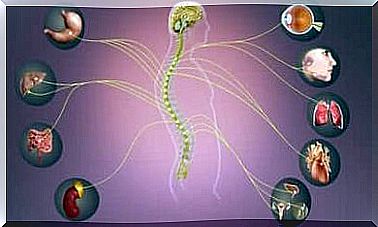Fairburn’s Therapy For Bulimia Nervosa

Fairburn therapy is a defined psychological intervention to treat bulimia nervosa. The latter is an eating disorder characterized by frequent episodes of bingeing and relative loss of control.
These binges are followed by compensatory behaviors that consist of self-induced vomiting or the intake of laxatives. These behaviors occur in response to the immense anxiety that the person with bulimia feels after binging.
The strong feeling of guilt or embarrassment leads to purging, with the intention of remedying what happened.
Currently one of the most effective treatments, therefore most used in clinical practice, is Fairburn’s cognitive behavioral therapy.
This treatment is on an individual basis and lasts for approximately five months. It is semi-structured, problem-oriented, and focuses primarily on the present and future, rather than the past.
Fairburn therapy consists of three distinct phases which we will explain in more detail. The overriding goals are to get the patient in control of their diet, to make sure that the ideas they have about weight, silhouette and body image change and that these changes are permanent.

The stages of Fairburn therapy for the treatment of bulimia nervosa
Phase 1
It lasts about 8 weeks and is conducted through weekly interviews, except in cases where the patient’s diet is particularly uncontrolled. In such cases, it is considered useful to agree on more than one session.
The first step is to reconstruct the patient’s personal history and identify the main points of interest to process the treatment. Subsequently, we move on to the explanation of the cognitive model of bulimia nervosa.
This model reveals the vicious circle caused by this disorder. There is a crucial factor, namely the idealization of weight and body figure that would lead the patient to do low-calorie diets.
Self-esteem and eating disorders
It is believed that the cognitive factor, or basing self-esteem on physical appearance, is the cause of the disorder. The typical cognitive impairment of bulimia nervosa has two main aspects: dissatisfaction with the body figure itself and overrated ideas about weight and silhouette. This last aspect is found in all cases of bulimia.
In this first phase the patient will have to monitor what he eats, recording it in a diary . The idea of self-registration is to make the person more aware of their problem and to identify what is causing the binge eating.
The recordings will be carefully analyzed session by session. It is necessary for the patient to reflect on what he was doing just before the binge and what thoughts were going through his mind at the time.
On the other hand, it is convenient for the person to start weighing himself only once a week. Some patients never weigh themselves as avoidance behavior and others do it 5 or 6 times a week as a method of reassurance.
For this reason, it would be best to do this only once and the weight should be recorded in the diary, also noting thoughts about it, for later discussion during the session.
Additional strategies
Other strategies applied in this initial phase are: information and psychoeducation on eating patterns, compensatory behaviors such as the use of laxatives or diuretics or the negative effects of diets.
Finally, the patient is trained in stimulation control. It is a technique widely used as a method of self-control starting from a behavioral perspective.
Some of the recommended guidelines are: do not engage in any activity while eating, always eat in the same place, leave food on your plate, limit exposure to “dangerous” foods, etc.
Phase 2 of Fairburn therapy
It is a phase more focused on the cognitive part, therefore the main technique will be restructuring. It lasts 8 weeks, with one session per week. At this stage, it is a priority to eliminate the diet. Since it makes binges easier to occur, it should be stopped.
In addition, the patient is advised to start eating foods that he avoids. These avoided foods are classified according to the degree of rejection and divided into 4 groups of increasing difficulty.
Each week the therapist instructs the patient to eat one of these forbidden foods, starting with the easiest group.
After adopting these techniques, we begin with cognitive therapy. Since the patient in the first phase has already identified the negative thoughts, it is time to teach him what cognitive distortions exist and to analyze those with which he identifies most.

So…
To identify the underlying thoughts, the therapist may propose various behavioral tricks or assign homework such as looking in the mirror, wearing tight-fitting clothes, etc.
Based on these tasks, the patient notes what is on his mind. During the session, these notes will be analyzed, verifying their truthfulness, consistency and how convenient it is to think in this way.
Finally, in this phase it is advisable to let the patient work on problem solving. In this way he will learn that there are certain circumstances in life that do not have a clear solution, and that sometimes the best solution is to analyze step by step the alternatives in front of us in order to implement a specific strategy.
Phase 3
This is the last phase of Fairburn’s therapy: it consists of 3 sessions every fortnight. The aim is to prevent relapses.
At the end of the treatment, the patient feels much better, but often still has some symptoms. For this reason, the psychotherapist helps him to distinguish between fall and relapse.
A fall is a small “slip” and is part of the path; it must therefore be normalized and we proceed. A relapse, on the other hand, presupposes a return to the starting point. The latter must be avoided and controlled.
At this last stage, the patient needs to have a personal and written strategic plan of what to do if he or she recognizes the symptoms of a relapse.
Fairburn Therapy Conclusions
Fairburn’s therapy for bulimia nervosa is currently one of the most empirically supported treatments.
Furthermore, it is not only used in bulimia, but in its transdiagnosis format it has also been shown to be effective in treating other problems, such as binge eating disorder.









